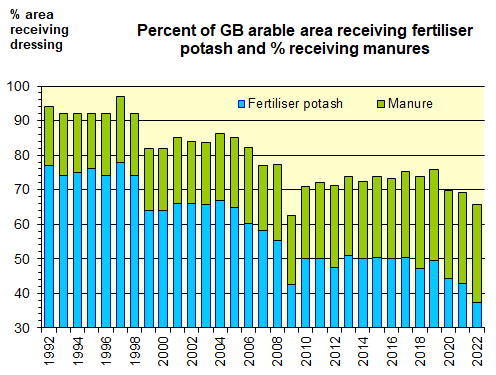Global Food Security Threatened by Potassium Neglect
April 2024
Inadequate potassium management jeopardises food security and freshwater ecosystem health. Potassium, alongside nitrogen and phosphorus, is a vital nutrient for plant growth and will be fundamental to achieving the rapid rises in crop yield necessary to sustain a growing world population. Sustainable nutrient management is pivotal to establishing sustainable food systems and achieving the United Nations (UN) Sustainable Development Goals. While momentum to deliver nitrogen and phosphorus sustainability builds, potassium sustainability has been chronically neglected. There are no national or international policies or regulations on sustainable potassium use equivalent to those for nitrogen and phosphorus. Calls to mitigate rising potassium soil deficiency by increasing potassium inputs in arable agriculture are understandable.
An estimated 20% of global agricultural soils face severe potassium deficiency with the global trend over recent decades showing more potassium is removed than applied in harvests. Large agricultural areas are reportedly deficient in ‘crop-available’ soil potassium. Depleting crop-available potassium threatens crop productivity and food security. In some countries, despite the perception of potassium-rich soils, negative soil potassium balances are causing crop yield losses. These issues, exacerbated by limited or absent potassium fertilisation, emphasise the need for site-specific management.
Help farmers maintain sufficient soil potassium levels
Defining ‘sufficient’ potassium to avoid crop yield losses involves local assessment. Studies conducted in the United Kingdom demonstrated that the spring barley yield in response to nitrogen application was ∼40% lower in soils with low potassium levels than in those with high potassium levels. However, further research is required to better assess the yield implications of potassium limitation across diverse crops and soils. Such assessments should consider soil potassium stocks, soil characteristics, crop types and leaching potential, and may be greatly affected by the incorporation of measures to reduce potassium losses. National-scale assessments are essential to address knowledge gaps and to develop targeted fertiliser recommendations for optimal crop yields and environmental sustainability.
Article taken from Nature. Brownlie, W.J., Alexander, P., Maslin, M. et al. Global food security threatened by potassium neglect. Nat Food 5, 111–115 (2024). https://doi.org/10.1038/s43016-024-00929-8
Editorial comment from PDA
Although this article focusses on the global issues, the UK could be deemed to be one of the perceived potassium-rich countries highlighted. Although some UK areas may be high in K, or on potassium releasing clays, data from the British Survey of Fertiliser Practice (BSFP) has identified for some time that potassium inputs are not matching potassium offtake. This, combined with data from the PAAG soil tests suggest that growers in the UK cannot afford to take their eye off the ball with potassium management; particularly with the potential yield losses highlighted above.
The BSFP chart below shows the percentage of the GB arable area which receives an annual application of potash fertiliser along with the percentage of arable area receiving manure. Assuming that the same land does not receive both, then it is clear that at best only about 65-70% of the total arable area receives some annual potash. This will not be sufficient to maintain soil reserves across the UK.


